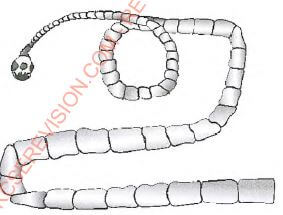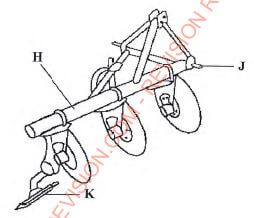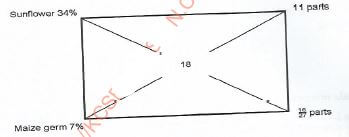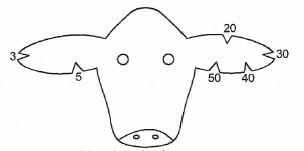QUETSIONS
SECTION A (30 marks)
Answer all the questions in this section in the spaces provided.
- State six characteristics of a good breeding stock.(3 marks)
- State four reasons for maintaining farm tools and equipment.(2 marks)
- State four reasons why a calf should be fed on colostrum.(2 marks)
- Give two reasons for growing grass around a fish pond.(1 mark)
- Name four systems of poultry rearing,(2 marks)
- State three advantages of contemporary comparison method of selecting breeding stock.(11/2 marks)
- Give the meaning of the following terms as used in livestock breeding:
- close breeding(1/2 mark)
- line breeding(1/2mark)
- out crossing (1/2 mark)
- cross breeding (1/2 mark)
- State four livestock rearing practices undertaken in a crush to control parasites and diseases.(2 marks)
- Name the dairy cattle breed that
- produces the highest milk yield in kilograms(1 mark)
- is fawn/brown coloured with white colour on the face, legs below knees and hocks, tail switch and flanks(4 mark)
- is most suitable for marginal areas with poor pastures.(2 mark)
- Distinguish between each of the following breeding practices:
- crutching and ringing(1 mark)
- tupping and serving(1 mark)
- What is a predisposing factor of a disease?? (1 mark)
- State four candling qualities of good eggs for incubation(2 marks)
- Apart from the roof, name four other parts of a building that can be constructed using wood.(2 marks)
- State four symptoms of internal parasite infestation in livestock.(2 marks)
- State the functional difference between the following:
- cross-cut saw and rip saw(1 mark)
- wood chisel and cold chisel(1 mark)
- Give the meaning of the following terms as used in livestock health:
- predisposing factor(1 mark)
- incubation period(1 mark)
SECTION B (20 marks)
Answer all the questions in this section in the spaces provided.
- The diagram below shows a livestock parasite

- Identify the parasite.(1 mark)
- Explain how the parasite is passed from
- livestock to human beings(1 mark)
- human beings to livestock(1 mark)
- Explain two control measures for the parasite in a zero grazing unit.(2 marks)
- The diagram below illustrates a tractor drawn implement

- Identify the implement(1 mark)
- Name the part labelled
H....................... (1 mark)
J........................ (1 mark) - State one function of the part labelled K(1 mark)
- Explain why the implement is suitable for ploughing areas with hidden stones. (1 mark)
- A farmer is required to prepare 200 kg of dairy meal containing 18% digestible crude protein (DCP). Using the Pearson's Square Method, calculate the quantity of sunflower seed cake (34% DCP) and maize germ (7% DCP) the farmer requires for the dairy meal.(5 marks)
- The diagram below represents a practice of identifying livestock on a farm.

- Identify the practice(1 mark)
- Determine the number that identifies the animal represented by the illustration (1 mark)
- Draw a diagram of the animal identified by the number 148 on the farm.(1 mark)
- Give two reasons why this method of identification is discouraged in livestock roaring.(2 marks)
SECTION C (40 marks)
Answer any two questions from this section in the spaces provided after question 23.
-
- Describe how naural incubation is set up and managed.(8 marks)
- Describe the management of growers in poultry rearing,(5 marks)
- Describe seven possible sources of power on a farm.(7 marks)
-
- Describe pneumonia disease under the following sub-headings:
- causal organism(1 mark)
- animals affected(2 marks)
- predisposing factors(2 marks)
- symptoms (5 marks)
- control measures.(3 marks)
- Explain seven housing requirements for a calf.(7 marks)
- Describe pneumonia disease under the following sub-headings:
-
- State five signs of heat in cattle.(5 marks)
- State five advantages a spray race has over a plunge dip.(5 marks)
- Give five reasons for maintaining livestock healthy.(5 marks)
- Explain five factors that determine the amount of food eaten by a livestock animal.(5 marks)
MARKING SCHEME
-
- Young:
- Healthy:
- Prolific;
- High performer/yielder;
- Free from physical deformities;
- Fertile;
- Proper body conformation;
- Adapted to local conditions:
- Good mothering ability,
-
- Ensure efficiency:
- Make them durable;
- Reduce replacement costs;
- Avoid injury to the user,
-
- Highly digestible;
- Highly nutritious;
- Contains antibodies which boost immunity,
- Has laxative effect;
- Highly palatable;
-
- Stabilize the banks;
- Attract insects which lay eggs that hatch into larvae for fish food;
-
- Free range:
- Deep litter;
- Fold;
- Battery cage;
-
- It is possible to compare animals of different age groups;
- Eliminates differences due to environmental factors;
- It is possible to compare bulls of different artificial insemination centres;
- It is accurate;
-
- Close breeding - Breeding of closely related animals;
- Line breeding:- Mating of distantly related animals that share a common ancestry;
- Out crossing. Mating of unrelated animals within the same breed;
- Cross breeding - Mating of two animals of different breeds;
-
- Vaccination;
- Deworming;
- Hoof trimming;
- Spraying;
- Dehorning;
- Treatment/injection;
-
- Friesian;
- Guernsey
- Jersey,
-
- Crutching:-Cutting of wool around the external reproductive organ of a female sheep to facilitate mating while
Ringing - Trimming of wool around the sheath of the penis in rams to facilitate mating: - Tapping:- Act of mating in goats and sheep;
Serving - Act of mating in cattle and pigs
- Crutching:-Cutting of wool around the external reproductive organ of a female sheep to facilitate mating while
- Conditions which lead to the animal contracting a disease;
-
- Fertile (has germinal disk: black spot);
- Free from blood spots;
- Large air space;
- Free of hair cracks;
- Free of excessively porous shell;
- Free of broken shells;
-
- Floor;
- Ceiling
- Door:
- Windows;
-
- Starring coat;
- Eggs and parasites seen in faeces;
- General emaciation;
- Diarrhoea;
- Pot-bellies;
- Anaemia;
- Anorexia;
- Dehydration/pale mucosa;
-
- Rip saw: - cuts along the grain of wood.
Cross-cut saw - cuts across the grain of wood; - Wood chisel-cutting grooves/chopping rough wood surface;
Cold chisel - cutting thick sheets of metal.
- Rip saw: - cuts along the grain of wood.
-
- Conditions inside or outside the animal body which make it to contract a disease;
- Is the duration between the time of infection and the time the first symptoms show up;
-
- Tapeworm;
-
- Ingestion of bladder worm;
- Ingestion of eggs (proglottids) passed in Human Reus during grazing/feeding:
-
- Use of antihelmintics/deworming to kill endo-parasites;
- Proper hygiene in the unit,
- Proper use of latrines to prevent contamination by infected faeces;
- Proper cooking of meat to destroy bladder worms;
- Use of clcan food, feeders, water and waterers to prevent contamination;
-
- Dies plough:
- H-Beam;
J-Lower link attachment point; - Counteracts the thrust by the discs to balance the plough;/helps to adjust the depth of ploughing:
- The dises are able to roll over obstacles;
-

Sunflower = 11 x 200 = 81.48kg;
27
Maize germ = 16 x 200=118.52kg:
27 -
- Ear notching;
- 155;
-

-
- The notching is painful to the animal;
- Notched wounds cause secondary infections;
-
-
- Provide the broody hen with a nesting box which should be spacious to allow movement of the hen;
- Provide nesting material in the nesting box to maintain warmth;
- Provide the broody hen with 10-15 eggs;
- Keep the nest in a dry, and well-ventilated area;
- Provide the hen with balanced feed and water;
- Dust the hen with appropriate insecticides to control external parasites;
- Allow the hen to go out at least once to exercise and feed;
- Do not disturb the hen when the eggs start hatching;
-
- Provide adequate floor space, feeders, and waterers;
- Provide litter on the floor up to 15cm deep:
- Provide growers mash adlib;
- Provide plenty fresh water,
- Dust the birds with appropriate insecticides to control external parasites;
- Keep the litter dry to avoid dampness;
- Provide grit or oyster shells towards the end of growers stage/at 12 weeks;
- Gradually introduce layers' mash from the 16th week until it completely replaces growers' mash at 18th - 19th week.
-
- Human power:- Working directly or utilizing their capacity of organization;
- Animal power e.g. donkeys, oxen camels for cultivation and transportation;
- Wind power e.g. for winnowing, pumping water and turning turbines;
- Water power eg, driving turbines to produce HEP driving maize grinding mills and pumping water;
- Biomass e.g. Biogas, wood or charcoal;
- Solar radiation in photosynthesis, drying crops, generate electricity, etc;
- Electric power from geothermal, hydropower and nuclear stations, battery;
- Fossil fuel:- petroleum, coal, natural gas, etc;
- Tractor:- Burns petrol or diesel to produce power which is transmitted and used in different ways;
-
-
-
-
- Bacteria/virus/Mycoplasma mycoides;
- Dust and worms in the lungs;
- Calves, kids; lambs; piglets; poultry,
-
- Poor ventilation;
- Overcrowding:
- Age- young animals;
- Diarrhoea and other illnesses;
-
- Dullness;
- Loss of appetite;
- Starring coat;
- Emaciation;
- Rapid breathing;
- Fluctuating body temperature;
- Nasal mucous discharge;
- If chest is pressed, animal starts coughing;
-
- Keep young animals in warm houses;
- Proper sanitation;
- Isolation;
- Treatment using antibiotics;
-
- Concrete/slatted floor to facilitate cleaning;
- Spacious to allow exercise, feeding and watering;
- Single housing to prevent licking of one another/ skin infections and spread of worms;
- Well lit to facilitate synthesis of vitamin D;
- Well drained to prevent dampness which predisposes the calf to infections;
- Free from draughts: Solid on the wind ward side to prevent entry of cold winds;
- Leak proof to avoid dampness/wetness which encourages infections;
-
-
-
-
- Restlessness;
- Mounting others and stands still when mounted;
- Slight rise in temperature;
- Slight drop in milk yield;
- Vulva swells and becomes reddish;
- Clear or slimy mucus discharge from vagina;
- Frequent mowing:
-
- Suitable for pregnant and sick animals;
- Animals do not swallow the acaricide wash;
- Spraying is faster,
- It is less laborious;
- Acaricide wash is not wasted as it is recycled;
-
- Healthy animals grow fast and mature early;
- Animals give a longer productive life;
- Produce good quality products;
- Give maximum production/performance;
- Prevent spread of diseases;
- Healthy animals are economical to keep:
-
- Body size or weight of the animal; large animals eat more food;
- Environmental conditions where the animals is; animals in cold areas require more food;
- Physiological condition of the animal; lactating animals require more food;
- Level of production:- High producers also require more food;
- Purpose for which the animal is kept: animal kept as a pet requires less food than the one kept for production or performance;
-
Download KCSE 2018 Agriculture Paper 2 with Marking Scheme.
Tap Here to Download for 50/-
Get on WhatsApp for 50/-
Why download?
- ✔ To read offline at any time.
- ✔ To Print at your convenience
- ✔ Share Easily with Friends / Students

